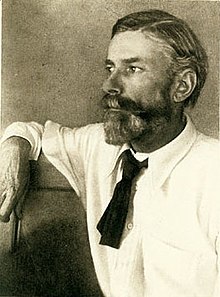Our website is made possible by displaying online advertisements to our visitors.
Please consider supporting us by disabling your ad blocker.
Edward Carpenter
Edward Carpenter | |
|---|---|
 | |
| Born | Edward Carpenter 29 August 1844 |
| Died | 28 June 1929 (aged 84) |
| Resting place | Mount Cemetery, Guildford, England |
| Occupations | |
| Partner | George Merrill (1891–1928) |
| Signature | |
Edward Carpenter (29 August 1844 – 28 June 1929) was an English utopian socialist, poet, philosopher, anthologist, an early activist for gay rights[1] and prison reform whilst advocating vegetarianism and taking a stance against vivisection.[2][3] As a philosopher, he was particularly known for his publication of Civilisation: Its Cause and Cure. Here, he described civilisation as a form of disease through which human societies pass.[4]
An early advocate of sexual liberation, he had an influence on both D. H. Lawrence[5] and Sri Aurobindo, and inspired E. M. Forster's novel Maurice.[6][7]
- ^ Smith, Warren Allen (2000). "Carpenter, Edward (1844–1929)". Who's Who in Hell, A Handbook and International Directory for Humanists, Freethinkers, Naturalists, Rationalists, and Non-Theists. New York: Barricade Books. p. 186. ISBN 978-1-56980-158-1. OCLC 707072872 – via Internet Archive.
- ^ Rowbotham, Sheila (2008). Edward Carpenter: A Life of Liberty and Love. Verso. p. 310. ISBN 9781844672950.
- ^ O'Neill, Charlotte (7 January 2019). "Edward Carpenter: A Nonhuman Bibliography, by Charlotte O'Neill – Sheffield Animal Studies Research Centre". Sheffield Animal Studies Research Centre. Retrieved 23 October 2019.
- ^ Carpenter, Edward. Civilisation, Its Cause and Cure.
- ^ Delaveny, Emile (1971) D. H. Lawrence and Edward Carpenter: A Study in Edwardian Transition. New York: Taplinger Publishing Company. ISBN 978-0800821807
- ^ Andrew Harvey, ed. (1997). The Essential Gay Mystics.
- ^ Symondson, Kate (25 May 2016) E M Forster’s gay fiction Archived 10 August 2020 at the Wayback Machine. The British Library website. Retrieved 18 July 2020
Previous Page Next Page


